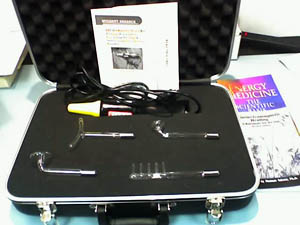|
I just returned from an interesting energy and
environment conference in South Korea http://icus.org/video/ called the 24th International Conference on the Unity of the
Sciences. We have posted a few of the pictures from the
conference on Facebook. It proved to me that a moral imperative
to helping the earth can be a motivating factor for scientists.
Regarding the expected concern for global warming and sea level
rise, some of the best solutions for carbon sequestration that I
found was from www.climatefoundation.org where Dr. Brian Von Herzen
leads the development of kelp forests for restoring global
mariculture and previously nurturing of plankton
geoengineering (featured on the Discovery channel) since
they both have the potential for sucking billions of tons of
carbon from the atmosphere.
Our
first story is probably a view of the future, since Stanford
University’s development of wireless transmission charging
for moving electric vehicles is so exciting to everyone
who has “range fear.” IRI expects to see highways offering
inductive coupling mobile wireless charging as well in the near
future, such as described in Chapter 16 of our book Nikola Tesla’s
Electricity Unplugged “High Q Resonant Wireless Power
Transfer” by Roy Davis from Qualcomm.
Story #2
features the advanced energy harvesting for wearables developed
by NASA with both thermoelectric generators and ambient
solar energy usage for a higher power level.
Story #3
is a surprising use of gravity for generating energy with the
help of old mine shafts by Gravitricity. Surprisingly, it can
generate 20 MW of power with heavy weights in shafts from 500 to
5000 feet, lasting up to 50 years without degradation.
Visit www.gravitricity.com for more information.
Story #4
gives us hope for India becoming a leader in zero emissions
energy generation by doubling its capacity to generate wind power
in Tamil Nadu, along with 13 GW of solar energy, overcoming its
addiction to coal.
Our
fifth story offers an unusual method for storage of information
without electronics. It uses conductive thread that can store
magnetic information that is read by an inexpensive instrument.
|
|
1) Wireless Charging of Moving Electric Vehicles
|
|
|
|
CLICK PICTURE TO VIEW VIDEO
|
Stanford University,
February 2018
If electric cars could
recharge while driving down a highway, it would virtually
eliminate concerns about their range and lower their cost,
perhaps making electricity the standard fuel for vehicles.
Researchers have wirelessly transmitted electricity to a nearby
moving object, which could advance wireless charging of vehicles
and personal devices such as cellphones, and untether robotics in
manufacturing.
|
|
2) Wearable Solar Thermoelectric Generator
|
|
This energy-harvesting system generates
electricity by attachment to clothes, windows, or outer building
walls.
|
|
|
|
Techbriefs.com February 2018
There has been a great increase
in the study of wearable thermoelectric generators using the
temperature difference between body heat and the surrounding
environment. One of the main drawbacks of wearable TEG techniques
driven by body heat is that such temperature difference is only 1
to about 4 °C, and this has hindered further commercialization.
|
|
|
3) Generator of Energy using Gravity
|
|
|
|
Turning Old mine shafts into energy generators
By Kristin Longren, Habitat.com February 2018
The coal mining industry is dying
(despite what some people would have you think), and it isn’t
coming back. But a new startup is breathing life into mining
communities with an ingenious design that uses old mine shafts to
generate energy.
Gravitricity has devised a giant
weight system that drops down into disused mine shafts to create
power on demand using gravity.
|
|
4) India Becoming a Global Leader in Clean Energy
|
|
|
|
India's
southern state of Tamil Nadu is poised to become a global leader in
wind power, according to a new report.
BBC News, February 9th, 2018
But first the state must overcome
its addiction to coal, writes Nityanand Jayaraman. The report - by
the US-based Institute of Energy Economics and Financial Analysis -
predicts that by 2027, more than half of Tamil Nadu's power will be
generated by "zero emissions" technologies - notably
solar and wind.
|
|
5) Smart Fabric Stores Data without
Electronics
|
|
|
|
The fabric can store data without requiring onboard
electronics or sensors.
NASA Techbriefs.com
February 2018
Conductive
thread — embroidery thread that can carry an electrical current —
often is combined with other types of electronics to create fabric
that lights up or communicates. This thread also has magnetic
properties that can be manipulated to store either digital data, or visual
information like letters or numbers. This data can be read by a
magnetometer, an inexpensive instrument that measures the direction
and strength of magnetic fields, and is embedded in most
smartphones.
|
|










